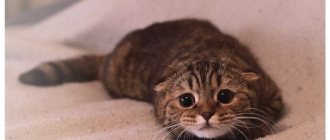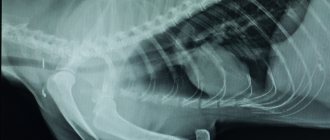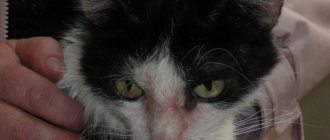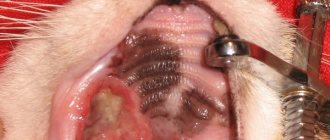Epilepsy (Latin name caduca) is a neurotic disease manifested in a predisposition to sudden seizures. The pathology is purely functional in nature; organic changes in nerve tissue do not occur in this disease. The tendency to seizures does not depend on the breed, but this disease is much less common in cats than in cats. If you have a feline living at home, it is useful to know the main symptoms of epilepsy and know what to do if your cat has a seizure.
First aid
A cat's behavior during a seizure is uncontrollable - the pet may accidentally injure itself. The owner must prevent possible injuries as much as possible.
What to do during an epileptic seizure
- Do not touch your pet or try to move it. The exception is the threat of falling from a height. If the cat has an attack on a windowsill, stairs or high furniture, lower it to the floor with a thick towel.
- Remove all objects that the cat could hit. Place pillows on the corners of furniture, table legs, and doorways to prevent your pet from bumping into them.
- In a room with a sick animal, turn off the lights and electrical appliances, close the curtains, and turn the TV to silent mode.
- Ask household members to leave the room.
- Stay calm, don't fuss, don't make noise, don't try to talk to your pet - this can increase the neurological reaction.
- Don't hold the cat. It is allowed to raise the animal's head with a towel and turn it on its side to protect it from injury.
- Under no circumstances should you put your fingers near the animal’s mouth; the cat will bite and will not be able to open its jaws until the attack is over.
- You should not put your hand into the mouth, trying to pull the tongue out - the tongue will not stick if the animal is lying on a flat surface with its head turned to one side.
- Record the start and end times of the seizures. If possible, take a video of the attack - this will help your veterinarian in further diagnosis.
- After the seizure ends, call your veterinarian for advice. If the attack lasted longer than 5 minutes, call a specialist at home.
Important!
Never try to open your cat's teeth with your fingers or a spoon. Do not insert any objects into the mouth - this will injure the animal and yourself.
Is it possible to prevent the disease?
It is impossible to prevent the development of this disease. However, you can minimize the risk of its occurrence. This will be achieved by following a number of rules:
- Regularly carry out preventive veterinary examinations for the timely detection and elimination of signs of pathologies against which the cat may develop epilepsy.
- Avoid contact of your pet with stray animals while walking.
- Protect your four-legged friend from overheating and hypothermia.
- Do not leave household cleaning products, medications and chemicals unattended.
- Avoid injuring your pet as a result of jumping or falling from a height. When living above the first floor, it is necessary to close windows, including those on the balcony, or use special protective mechanisms.
- Use only veterinarian-approved medications.
- When you decide to get a pet, try to find out from the previous owners whether its parents had epilepsy.
- Prevent the cat from giving birth to kittens as a result of inbreeding.
- Trust the feline birth to experienced professionals.
- Protect the animal from stress.
- Provide your pet with a complete, balanced diet.
Reasons for appearance
Epilepsy manifests itself as uncontrolled muscle activity (convulsions) as a result of a temporary disruption of the normal functioning of the brain. The attack may be one-time or repeated with some frequency. In veterinary medicine, there are two groups of causes of epileptic seizures: congenital and acquired.
Congenital causes
- Congenital genetic abnormalities of the brain.
- Inbreeding is inbreeding. The first offspring is the most vulnerable.
- Birth injuries of newborns.
- Intoxication and infections during cat pregnancy provoke epilepsy in the kitten.
- Heredity. Breeding animals with defective genes.
Congenital causes of epilepsy in cats are identified solely by the results of diagnostic studies.
Acquired reasons
- Benign and malignant brain tumors.
- Traumatic brain injuries: bruise and concussion, contusion.
- Endocrine pathologies, hormonal imbalance.
- Heart failure.
- Bacterial and viral infections: infectious peritonitis, canine distemper, feline leukemia, rabies, bacterial meningitis.
- Lack of minerals (Mg, Ca) and vitamins (D, B2, B6, B12) necessary for the functioning of the nervous system.
- Stress. Fright.
- Endocrine pathologies.
- Prolonged fasting, violation of feeding regime.
- Helminthiasis is infection with worms.
- Urolithiasis, renal failure.
Important!
This group of causes is difficult to identify and is often not associated with a seizure. The attack and the cause that caused it can be separated by years.
Treatment
Treatment of epilepsy in cats involves stopping seizures with anticonvulsants and achieving long periods of remission.
Lifelong remission is achieved in 15-30% of cats. In other animals, it is only possible to reduce the frequency of attacks and ease their course.
True epilepsy is not completely curable.
Only pathology caused by acquired causes can be completely cured by eliminating these causes.
When an animal needs medication
The decision to begin treatment for epileptic seizures is made by a veterinarian based on data on their frequency and duration. The cat owner must record this data and report it to the specialist.
Treatment is not required if epilepsy attacks occur 1-2 times a year and the cat does not have any chronic diseases. The owner must constantly monitor the pet and create a safe environment for it.
When attacks are repeated monthly or more often, last longer than 5 minutes, their severity increases - the cat needs help.
Medicines and the regimen for their use are prescribed by a veterinary neurologist. Incorrect choice of drug and its dosage can increase the severity, frequency and duration of the seizure.
Medications
The arsenal of medications for the treatment of convulsive seizures in cats is small due to their severe toxicity.
Veterinarians prescribe:
- Phenobarbital is an effective anticonvulsant in syrup and tablets. Reduces the excitement of the cat's nervous system, increases stress resistance, and prevents the onset of an attack. The dosage is selected by the attending physician. Sold by prescription.
The recommended dose is 1-2 mg per 1 kg of live weight 2-3 times a day.
Contraindications: chronic liver diseases.
Side effect: lethargy, drowsiness, thirst.
- Diazepam is a drug used to relieve epileptic seizures and reduce brain activity. Facilitates the recovery period after a seizure. Has a pronounced anti-anxiety effect. Prescribed in the form of rectal suppositories.
Recommended dose: 1 mg per 1 kg of live weight. The first dose is administered at the onset of seizures, followed by subsequent doses within 24 hours at 8-hour intervals.
Contraindications: chronic liver diseases.
Side effect: depression, excitability, abnormal behavior.
- Imepitoin (Pexion) is a new veterinary drug for the treatment of idiopathic epilepsy. Available in tablets (100 and 400 mg). Rarely prescribed due to insufficient clinical trials. It is quite well tolerated by cats.
Dosage: selected individually by a veterinarian after confirming the diagnosis of idiopathic epilepsy.
Contraindications: weight below 5 kg.
Side effect: loss of appetite, vomiting.
Important!
Human medications for epilepsy should not be given to cats.
What should the owner of a sick cat do?
Cats with true epilepsy require lifelong treatment and monitoring by a veterinarian.
Its owner must strictly observe the following rules:
- Strictly observe the dosage of the medicine.
- Give medications as prescribed by your doctor at the same time every day.
- Do not turn to traditional medicine - it is powerless against epilepsy.
- Do not interrupt treatment without your veterinarian's permission.
- Visit the clinic every month for a blood test.
- Conduct neurological examinations regularly - at least once a month.
- Keep an observation diary: record the date, time, nature and duration of attacks, behavioral changes before the attack.
Important!
With prolonged use of drugs, a cat may develop anemia; it is necessary to constantly monitor hemoglobin levels.
How to know if treatment is helping
The prescribed treatment regimen is considered successful if the cat has completely stopped having epileptic seizures or their frequency has been halved. There should be no side effects from the medications taken. In order for the veterinarian to assess the effectiveness of the medications, the owner needs to keep an observation diary. It documents the dates of attacks, their type, characteristics and duration.
The treatment plan is reviewed by the veterinarian if the cat's seizure frequency has not decreased by 50%. This can happen due to incorrect diagnosis, the animal’s individual reaction to medications, or incorrectly selected dosage.
If your cat has been seizure-free for more than a year, your doctor may prescribe a gradual reduction in the dosage of medications. Stopping antiepileptic drugs at once is not allowed - this causes “withdrawal syndrome”.
Prevention
Even with effective treatment, symptoms of epilepsy in cats may return, including seizures—an increase in frequency, duration, and intensity.
To reduce risks, it is important to follow your doctor's recommendations:
- balanced feeding. Exclude bones, fatty foods, raw fish and meat, flour, sweets;
- treatment against parasites, vaccination, regular preventive examinations;
- free range is prohibited. Walking on a harness is allowed if before the illness they did not cause alertness or fear;
- it is important to ensure that the windows are closed - an attack that begins on the windowsill can result in death as a result of a fall;
- avoid stressful situations - noisy companies, quarrels, loud music, repairs. During the acute period, the pet is isolated, not forgetting to check its condition;
- castration is mandatory - epilepsy is inherited, the hunting period provokes stress, pregnancy and childbirth aggravate the condition.
Treatment for epilepsy in cats will take several months before the seizures stop. In addition to providing first aid, it is advisable for the owner to be able to give injections, artificial respiration and chest compressions. It’s great if this knowledge is not needed, but it can save your pet’s life.
Types of epilepsy
Depending on the reasons that caused the pathology, epilepsy in a cat is divided into:
- Congenital (idiopathic). The causes of the congenital form of the disease are difficult to diagnose. The disease accompanies the animal throughout its life. Over time, without proper treatment, the severity and duration of attacks may increase. The cat requires lifelong monitoring and supportive care.
- Acquired (symptomatic). Seizures in cats are a consequence of head injuries or a complication of other diseases. If the root cause is identified and treated adequately, the animal has a high chance of recovery.
Which cats are at risk?
A direct connection of this pathology with specific cat breeds cannot be traced, however, according to statistics, epilepsy is more often detected in representatives of exotic cat breeds than other cat breeds. In addition, male pets are more susceptible to this disease.
Kittens do not have attacks of the disease at an early age. Seizures, if we are talking about a congenital form of the disease, appear no earlier than the animal is 5 months old.
Symptoms
An epileptic seizure has several distinct phases, each of which has its own characteristic symptoms. Owners of cats need to know them in order to have time to provide first aid to the animal.
- The prodromal phase is preparation for an attack. It goes unnoticed by the owner. Lasts from several hours to 2-3 days. It is characterized by increased anxiety and nervousness of the animal.
- Harbingers (aura) - the animal reacts inadequately to its owners, gets scared by the slightest sound. The pet becomes absent-minded, lack of coordination, and slight muscle twitching are observed. The harbinger may be complete immobility of the pet. The duration of the period is from 1 to 30 minutes.
- A seizure (convulsive phase) is an epileptic seizure itself. Often begins in sleep. Characterized by large muscle spasms with deflection of the spine. The animal falls to the side. Partial numbness of the body is observed. The cat's breathing is heavy and intermittent. Possible loss of consciousness, involuntary defecation and emptying of the bladder. White or pink foam comes out of the mouth. The phase lasts from 2 to 30 minutes.
- The postictal phase is a period of recovery. The animal experiences weakness, lethargy and depression. Consciousness is confused, the cat does not recognize the owner, it gets scared. Increased appetite may develop. The recovery period may take up to 3 days.
In each cat, an epileptic seizure manifests itself in its own way, the phases last for different times, may be blurred, not clearly expressed.
Important!
Frequently repeated seizures lead to severe oxygen starvation and death (necrosis) of brain cells.
Status epilepticus
The most severe condition, leading to serious complications, including death, is status epilepticus.
This includes:
- Seizures that last more than 5 minutes.
- Seizures, during the intervals between which the cat does not have time to regain consciousness.
The danger of status epilepticus is that the animal’s brain experiences severe overload. Cats develop serious neurological pathologies and shorten their life expectancy. This condition requires prompt intervention by veterinary specialists.
How it manifests itself
The first thing that comes to mind is, of course, cramps. But this is only one (albeit the most striking) manifestation.
The mechanism of the attack is divided into three phases, which differ in their characteristics.
The first is the stage of short-term precursors , which, due to its transience, may not be noticed. At this time, the cat becomes restless and seemingly absent-minded (does not react to sounds or light), perhaps even shy.
Having caught this moment, you will notice that the muscles begin to twitch slightly, and the head is tilted to the side - the pet briefly loses coordination.
The next phase involves more serious convulsions . They are easy to spot:
- the muscles begin to contract rapidly, and the paws begin to twitch;
- saliva and foam come out of the mouth in large quantities;
- breathing becomes intermittent (after listening, you can identify a clear synchronized wheezing or groan);
- heart beats faster;
- uncontrolled release of urine or feces is possible;
- in some cases it even reaches the point of loss of consciousness.
This picture can be observed for several minutes (or even half an hour), after which the recovery . This means that within 5 minutes after the peak of the exacerbation the animal will be very weak and a little “lost” - this phase is characterized by prostration and disorientation in a familiar environment. After the specified time has passed, the purr returns to normal and runs to the bowl to eat or drink water.
Did you know? Cats excrete sweat through their paws—unlike humans, they do not have sweat glands throughout their bodies.
Note that here is a classic list of the main symptoms and phases. In practice, the boundaries between stages are often blurred. The same applies to the frequency of the attack: it can be repeated several times a day or occur once a month.
In any case, owners should know what to do if their beloved cat’s epilepsy has reached its peak form.
Important! Any attack, regardless of its duration, can be a reason to visit a doctor. Even a convulsion of a few seconds, if repeated frequently, will result in a lack of oxygen for brain cells.
Diagnostics
Only a veterinary neurologist can identify the cause of the pathology - do not try to do this yourself. The diagnosis of epilepsy is made based on the results of many examinations and laboratory tests, based on your notes from the observation log and video recording.
Diagnostic methods
- Anamnesis collection.
- Visual inspection of the animal, palpation of areas that cause suspicion.
- Ultrasound of the abdominal organs.
- Cerebrospinal fluid puncture.
- Computed tomography (CT) or MRI.
- Cardiogram.
- Analysis of urine.
- Electroencephalography.
- Radiography.
- Blood chemistry.
An important role in making a diagnosis is played by the description of the pattern of the attack: precursors, duration, nature of seizures in cats, time to recover from the condition. Having received the results of all studies, the veterinarian makes a final diagnosis.











